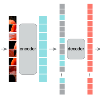In recent years, video streaming applications have proliferated the demand for Video Quality Assessment VQA). Reduced reference video quality assessment (RR-VQA) is a category of VQA where certain features (e.g., texture, edges) of the original video are provided for quality assessment. It is a popular research area for various applications such as social media, online games, and video streaming. This paper introduces a reduced reference Transcoding Quality Prediction Model (TQPM) to determine the visual quality score of the video possibly transcoded in multiple stages. The quality is predicted using Discrete Cosine Transform (DCT)-energy-based features of the video (i.e., the video's brightness, spatial texture information, and temporal activity) and the target bitrate representation of each transcoding stage. To do that, the problem is formulated, and a Long Short-Term Memory (LSTM)-based quality prediction model is presented. Experimental results illustrate that, on average, TQPM yields PSNR, SSIM, and VMAF predictions with an R2 score of 0.83, 0.85, and 0.87, respectively, and Mean Absolute Error (MAE) of 1.31 dB, 1.19 dB, and 3.01, respectively, for single-stage transcoding. Furthermore, an R2 score of 0.84, 0.86, and 0.91, respectively, and MAE of 1.32 dB, 1.33 dB, and 3.25, respectively, are observed for a two-stage transcoding scenario. Moreover, the average processing time of TQPM for 4s segments is 0.328s, making it a practical VQA method in online streaming applications.
翻译:近年来,视频流应用的需求增加了视频质量评估(VQA)的需求。减少参考视频质量评估(RR-VQA)是VQA的一类,在这种评估中,为质量评估提供了某些原始视频的特征(例如纹理、边缘)。它是各种应用的热门研究领域,例如社交媒体、在线游戏和视频流。本文引入了一种减少参考的转码质量预测模型(TQPM),以确定可能在多个阶段重新编码的视频的可视质量分数。使用视频的离散余弦变换(DCT)能量基础特征(即视频的亮度、空间纹理信息和时间活动)和每个转码阶段的目标比特率表示来预测质量。为此,问题被规划出来,并呈现出了基于LSTM的质量预测模型。实验结果表明,在单级转码情况下,TQPM平均产生PSNR、SSIM和VMAF预测,其R2分数分别为0.83、0.85和0.87,平均绝对误差(MAE)分别为1.31 dB、1.19 dB和3.01。此外,在两级转码情况下,观察到R2分数分别为0.84、0.86和0.91,MAE分别为1.32 dB、1.33 dB和3.25。此外,TQPM对于4s片段的平均处理时间为0.328s,在在线流应用中是一种实用的VQA方法。



